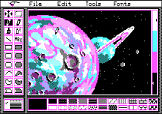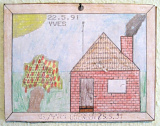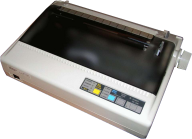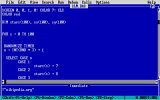Why computers
This story tells how I came to computers and especially programming over the years. It covers the time from 1990 to 2002. Later developments can be found on this website.
How it all began

Earth, 1990 (±1 year, I can’t remember exactly). At that time I was in elementary school and all I could use a computer for was painting. We had an old 286 with a pesky beeping EGA monitor and an even older painting program. So I had 320×200 pixels and whole four colours at my disposal. But it seems to have been sufficient to me. While my grandma had the usual hand-painted pictures from my younger cousins hanging in her kitchen, she got a crayon-coloured black and white dot matrix print of my landscape pictures from me.

Someday, I don’t remember how, I asked my father whether there is no different way. Shortly thereafter it was like this: I had 640×350 pixels and 16 colours (EGA). And Windows 3.1 and Paintbrush (what is now just Paint). Now in contact with a whole new world, I must have started to explore all sorts of things… For example, I can remember the masses of batch files I created that actually just took the user all through the system. To me it was fun! And then came the fatal step whose consequences have not been foreseeable at that time…
The printer manual

… the printer manual! I can already hear your question: “What’s that got to do with it?!” The answer is very simple: Such an over 10 years old printer could also do other things than printing “plain text” (believe it or not…). This included different line heights, custom characters or even entire graphics. And all of this was shown in that manual. Along with it some text that looked as if you had to type it in a text editor and print it. I don’t know how I came up with the idea either.




But then came the disappointment: I could print that text (or whatever you would call that incomprehensible letters and numbers mess) as often as I wanted – I always got exactly what I had typed in. No different line heights, self-defined characters and certainly no entire graphics! It was just “GIGO” (Garbage In, Garbage Out)… No longer understanding that grey monster, I ran to my supposedly omniscient father and he could help me out quickly. (Probably with a terribly evil grin on his face.) He entered a command that I did not know until then, and put me in front of a help text. “Here, just go and read it through!” must have been his words.
QBasic

I did not make it far in the text, then I returned from it and typed in all the text from the printer manual once again. After all, the editor looked the same as the old DOS editor. It was just a bit self-willed: Most of the text was automatically reformatted so that it looked just like in the book. Alright, text in the can, File, Print. Damn, again no success… But wait a minute, now there are some more menus… Edit – View – Run – sounds good, then Run Program – Program?? Well, never mind. Selected it and off you go. The printer reacted immediately and – I could not believe it – it really looked like it should!! A miracle happened, I was listened to, or the like.
Little programmer

Very proudly holding this and other print-outs in my hands, I went on looking at what I actually wrote there. Thanks to the quite detailled error messages of QBasic, I must have understood quickly what was going on. I had written my first computer program. Well, okay: typewritten. But then again I played around and by trying out things, I determined what was responsible for what. Then came a time when I did not want to know about painting at the PC. From now on, the “compiler” (that actually wasn’t one yet) was my new playground. And the keyboard my sand shovel. And monitor, printer as well as the PC speaker had to serve my inexhaustible inventiveness, for I learned to combine these elements more or rather less reasonably in the following months and years. During this time, I created countless effectively unusable DOS applications like calculators, screen savers, really ineffective password locks and so on.
After quite some QBasic and QuickBasic came a time of Turbo Pascal, also for DOS. I can only remember two amateur radio programs from that time, both of with were used at least by my parents: A first logbook to manage all radio contacts and QSL cards (here’s a successor), and a VHF contest program that kept all contest-relevant data like the contacts log, including a map to visualise locators for better adjusting the antenna direction. But eventually both became obsolete with our vanishing contest activities and the appearance of overlong callsigns – and also with the increasing use of Windows.
Windows

At first, I wrote many DOS programs because I was not convinced of Windows too much yet. While the whole window management was a lot easier, it was all a bit scary because much happend by itself and I could not control it. A rather tried to rebuild the graphical interface. Okay, let’s not talk about that… although I achieved considerable results on that. Even when Windows 95 came up, I still invented mostly DOS programs. Maybe that was because we still only had Windows 3.1 at school. And due to my participation in the computer course (some years later at grammar school, 7th/8th class) I was in touch with that technology there, too. In return, there was a Novell network and a lot to explore in its administration.
That sometimes led to minor disasters: When I wanted to install a selfmade April’s fool program, I had locked myself out of our class account and we could not use it for two weeks. And all I had needed to recover from it would have been the Supervisor password! But with our new computer room (10th class) which had extremely slow Windows 98 machines (for which I then took care more officially), I also dealt more with Windows programming at home (using Visual Basic 3-6 and some Delphi).
The internet

Until then, I only occasionally watched my father doing his banking business over the BTX service at his PC. We rarely seeked other things like software in that universe. Then in 1997, the internet came into my life. Back then, my father had access to the T-Online system which I could use, too, but soon I had my own modem at the 486 machine, meanwhile standing in my room, and I could enter the internet and T-Online myself. And by the end of the year, I already had some experience with HTML programming (with Microsoft Frontpage Express). I published the first draft of my own homepage in November ’97. Too bad that not many had access to the internet at that time, so nobody really noticed. Later we also had internet access at school and I could at least demonstrate my work to some schoolmates.
What then became of me: A little “network hacker” who creates his own toolz and other programs in PHP or Visual C++ by himself (and soon started making money with that), who maintains several homepages in the WWW and also dives deep into tinkering with his computer hardware. Only 3D action games somehow don’t mean a thing to me till present time. Lastly you would find me somewhere inside the specifications of diverse network protocols like HTTP or POP3.
![[de]](../../img/flags/de.png) Auf deutsch
Auf deutsch